
INFORMATION TO USERS This reproduction was made from a copy of a document sent to us for microfilming. While the most advanced technology has been used to photograph and reproduce this document,the quality of the reproduction is heavily dependent upon the quality of the material submitted. The following explanation of techniques is provided to help clarify markings or notations which may appear on this reproduction. 1.The sign or "target"for pages apparently lacking from the document photographed is "Missing Page(s)".If it was possible to obtain the missing page(s)or section,they are spliced into the film along with adjacent pages.This may have necessitated cutting through an image and duplicating adjacent pages to assure complete continuity. 2.When an image on the film is obliterated with a round black mark,it is an indication of either blurred copy because of movement during exposure, duplicate copy,or copyrighted materials that should not have been filmed.For blurred pages,a good image of the page can be found in the adjacent frame.If copyrighted materials were deleted,a target note will appear listing the pages in the adjacent frame. 3.When a map,drawing or chart,etc.,is part of the material being photographed, a definite method of "sectioning"the material has been followed.It is customary to begin filming at the upper left hand corner of a large sheet and to continue from left to right in equal sections with small overlaps.If necessary, sectioning is continued again-beginning below the first row and continuing on until complete. 4.For illustrations that cannot be satisfactorily reproduced by xerographic means,photographic prints can be purchased at additional cost and inserted into your xerographic copy.These prints are available upon request from the Dissertations Customer Services Department. 5.Some pages in any document may have indistinct print.In all cases the best available copy has been filmed. University Microfilms International a0A89BRa6o6
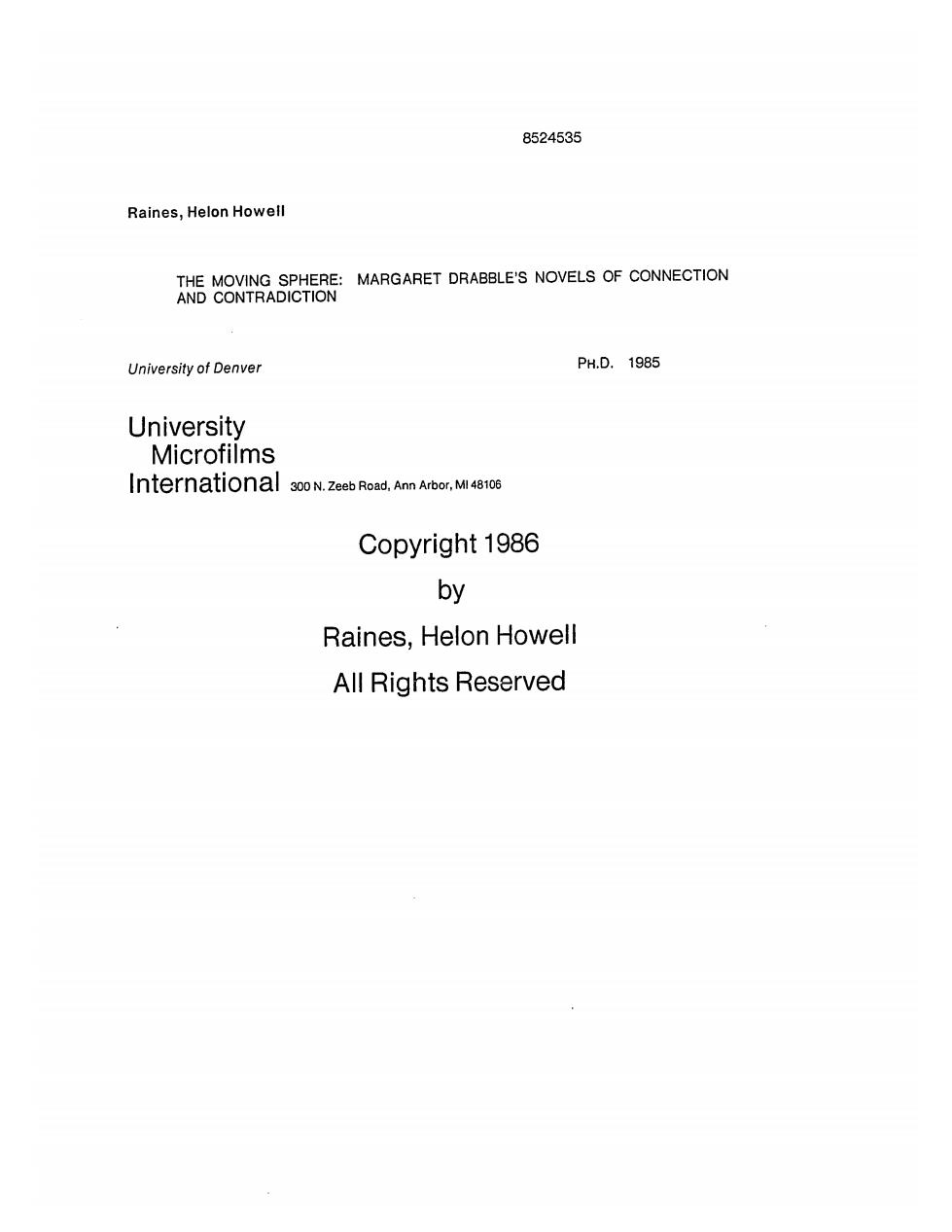
8524535 Raines,Helon Howell THE MOVING SPHERE:MARGARET DRABBLE'S NOVELS OF CONNECTION AND CONTRADICTION University of Denver PH.D.1985 University Microfilms International 300 N.Zeeb Road,Ann Arbor,Ml48106 Copyright 1986 by Raines,Helon Howell All Rights Reserved

THE MOVING SPHERE: MARGARET DRABBLE'S NOVELS OF CONNECTION AND CONTRADICTION A Dissertation Presented to the Faculty of Arts and Humanities University of Denver In Partial Fulfillment of the Requirements for the Degree Doctor of Philosophy by Helon Howell Raines August 1985
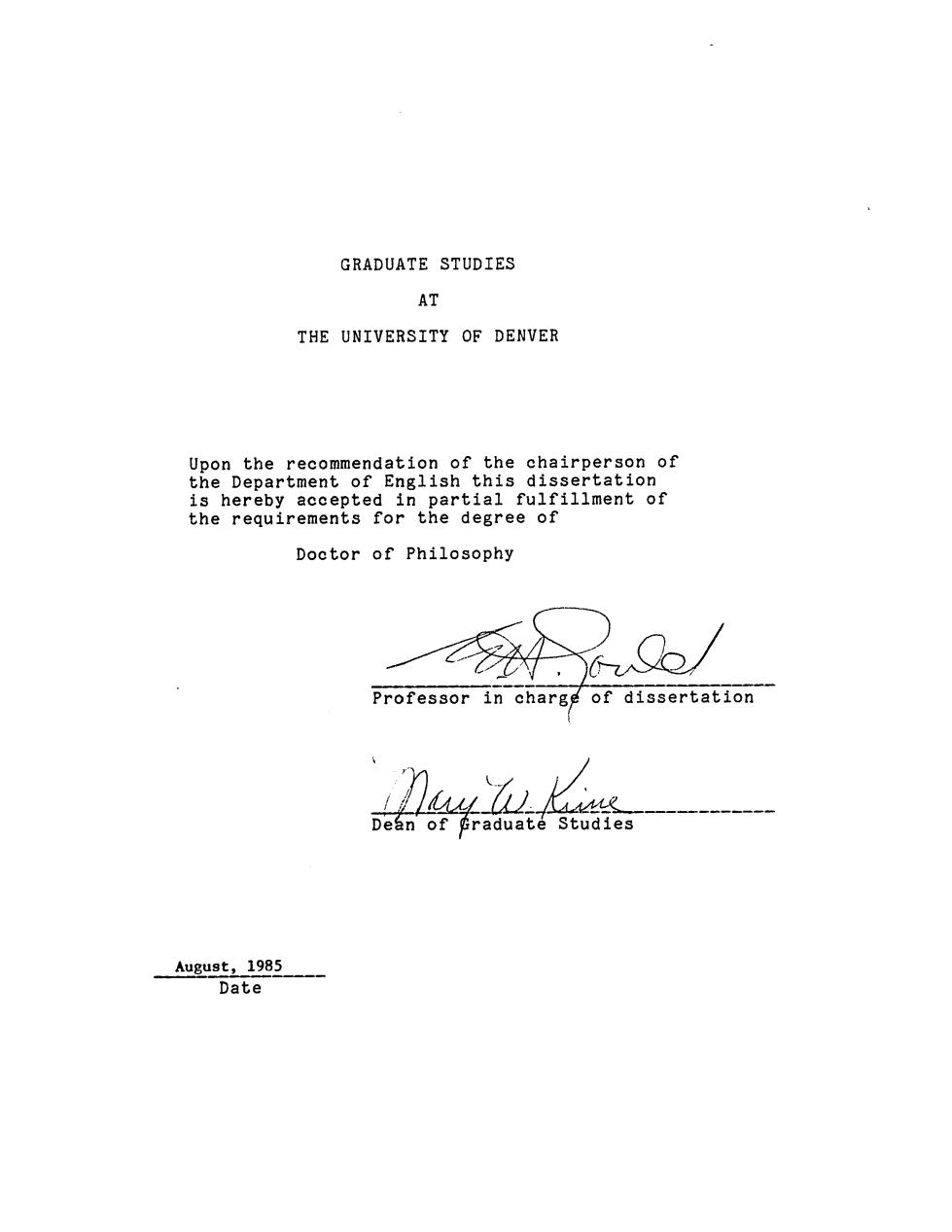
GRADUATE STUDIES AT THE UNIVERSITY OF DENVER Upon the recommendation of the chairperson of the Department of English this dissertation is hereby accepted in partial fulfillment of the requirements for the degree of Doctor of Philosophy Professor in charge of dissertation 44 Dean of Graduate Studies August,1985 Date
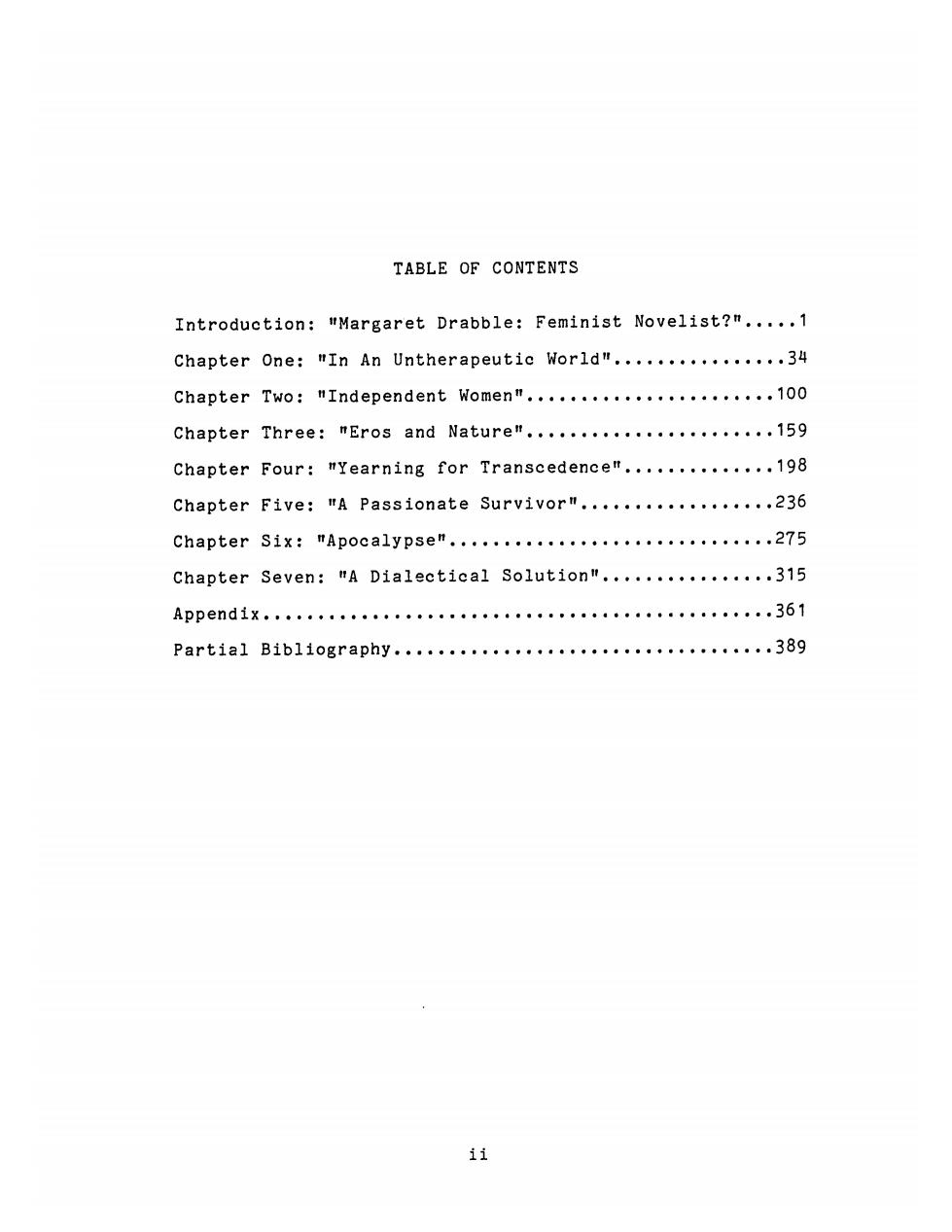
TABLE OF CONTENTS Introduction:"Margaret Drabble:Feminist Novelist?".....1 Chapter One:"In An Untherapeutic World"................34 Chapter Two:HIndependent Women".......................100 Chapter Three:mEros and Nature"............. .....159 Chapter Four:"Yearning for Transcedence"..............198 Chapter Five:"A Passionate Survivor"..................236 Chapter Six:mApocalypsem..............................275 Chapter Seven:"A Dialectical Solution"........... 。··.315 Appendix,·····。··。 ·…………….361 Partia1 Bibliography,············ .389 ii
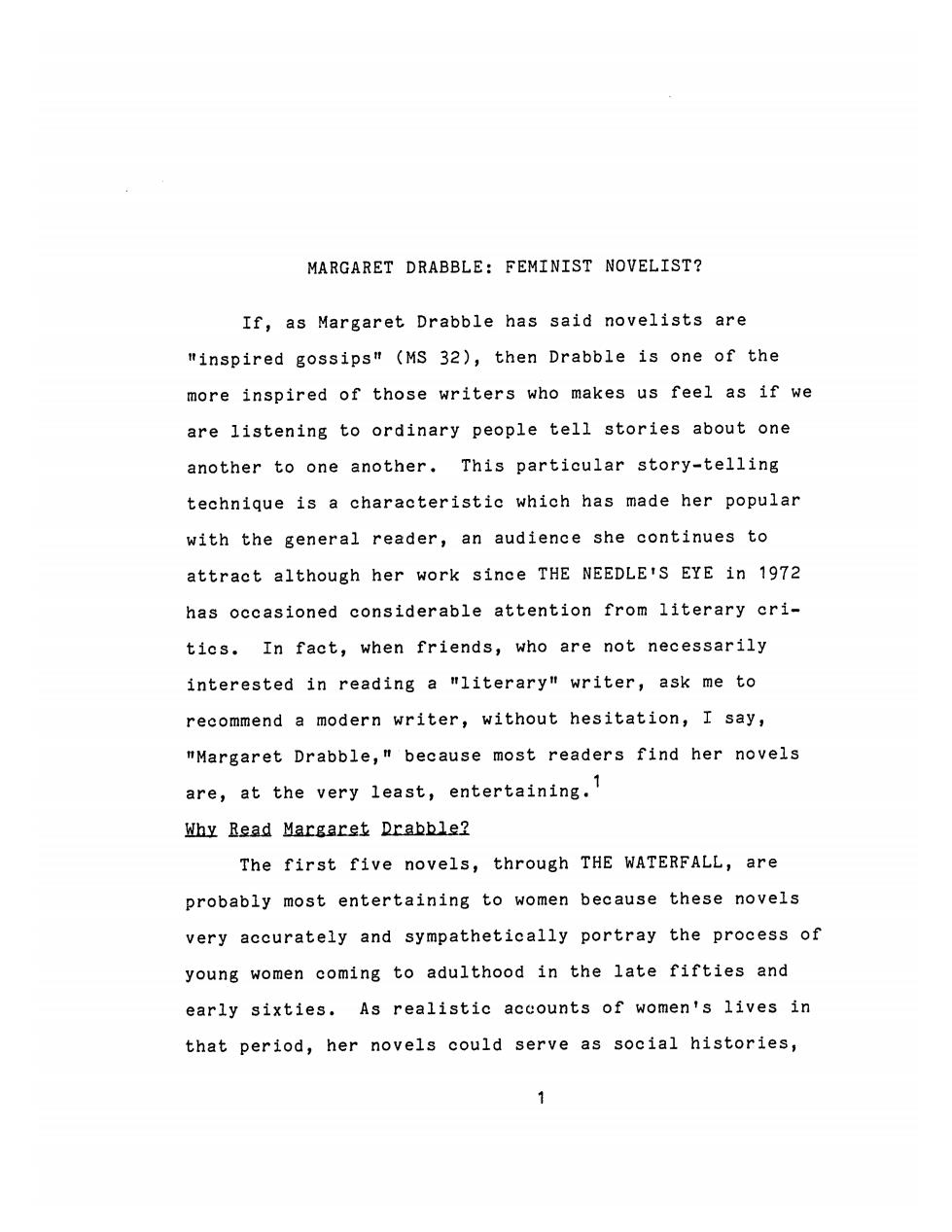
MARGARET DRABBLE:FEMINIST NOVELIST? If,as Margaret Drabble has said novelists are "inspired gossips"(MS 32),then Drabble is one of the more inspired of those writers who makes us feel as if we are listening to ordinary people tell stories about one another to one another.This particular story-telling technique is a characteristic which has made her popular with the general reader,an audience she continues to attract although her work since THE NEEDLE'S EYE in 1972 has occasioned considerable attention from literary cri- tics.In fact,when friends,who are not necessarily interested in reading a "literary"writer,ask me to recommend a modern writer,without hesitation,I say, "Margaret Drabble,because most readers find her novels are,at the very least,entertaining.1 Why Read Margaret Drabble? The first five novels,through THE WATERFALL,are probably most entertaining to women because these novels very accurately and sympathetically portray the process of young women coming to adulthood in the late fifties and early sixties.As realistic accounts of women's lives in that period,her novels could serve as social histories, 1
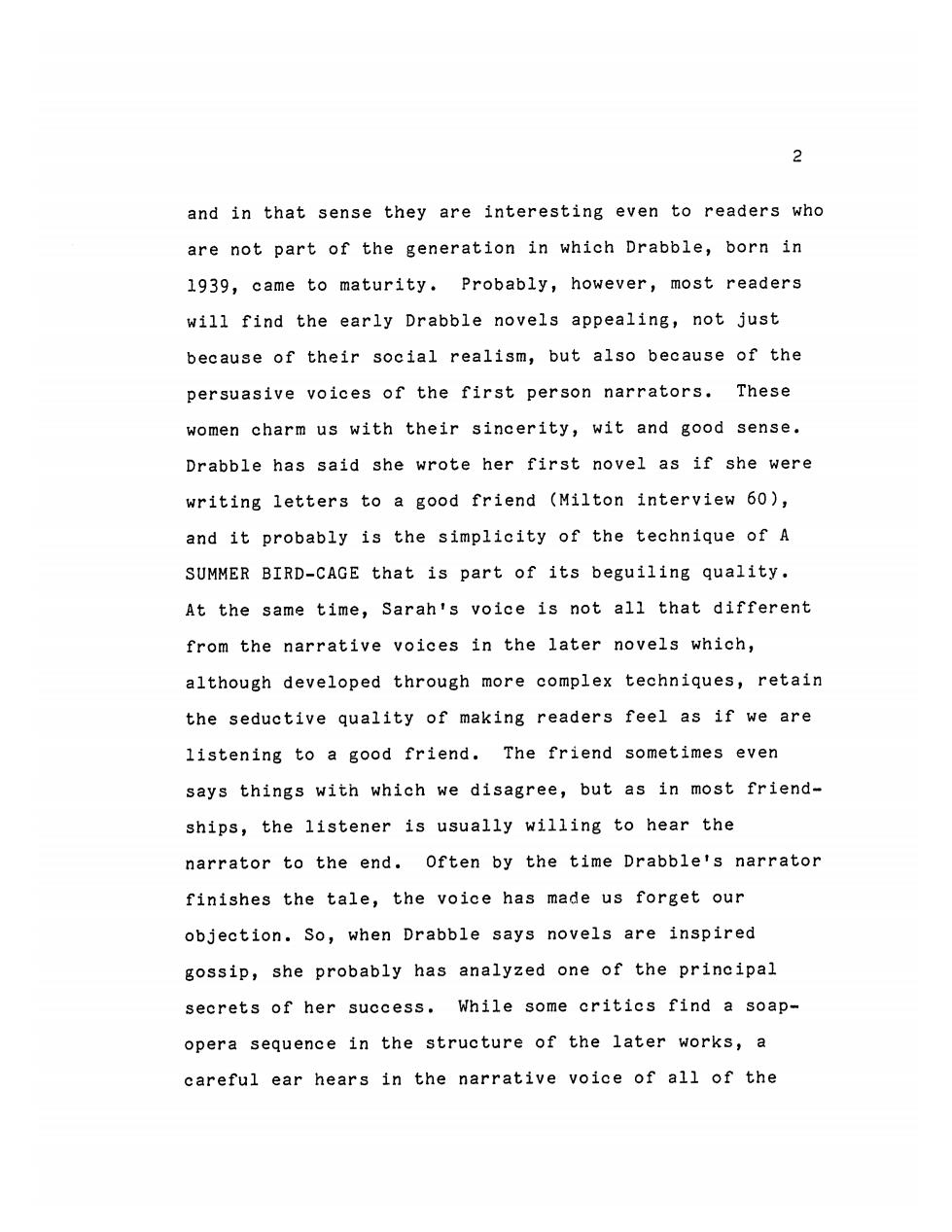
2 and in that sense they are interesting even to readers who are not part of the generation in which Drabble,born in 1939,came to maturity.Probably,however,most readers will find the early Drabble novels appealing,not just because of their social realism,but also because of the persuasive voices of the first person narrators.These women charm us with their sincerity,wit and good sense. Drabble has said she wrote her first novel as if she were writing letters to a good friend (Milton interview 60), and it probably is the simplicity of the technique of A SUMMER BIRD-CAGE that is part of its beguiling quality. At the same time,Sarah's voice is not all that different from the narrative voices in the later novels which, although developed through more complex techniques,retain the seductive quality of making readers feel as if we are listening to a good friend.The friend sometimes even says things with which we disagree,but as in most friend- ships,the listener is usually willing to hear the narrator to the end.Often by the time Drabble's narrator finishes the tale,the voice has made us forget our objection.So,when Drabble says novels are inspired gossip,she probably has analyzed one of the principal secrets of her success.While some critics find a soap- opera sequence in the structure of the later works,a careful ear hears in the narrative voice of all of the

3 novels this quality of "concerned interest"about the lives of friends.Therefore,when my colleagues who are knowledgeable about literature ask about major contem- porary writers I also respond,"Margart Drabble."often these people have read Drabble or at least have heard of her,something that might not have been true five years ago in the United States.If these colleagues also are feminists,a lively discussion is likely to ensue about whether or not Drabble is a feminist writer,an issue I will discuss at the end of this chapter.Certainly, however,any feminist should have read some of Drabble's work in order to know what one of the major British women writers is saying about the problems and possibilities of contemporary women。 One of the principal methods Drabble employs to develop her ideas is the strategy of the poet,using metaphoric language to play her characters against a backdrop of extensive and provocative imagery and symbolism.In fact,it certainly is the richness and depth of allusion,as well as of the figurative language, which contributes to Drabble's growing status among contemporary writers.Furthermore,the later Drabble works continue to develop sophisticated and unusual structures and narrative voices.The first person nar- rator of the early novels becomes a "technically
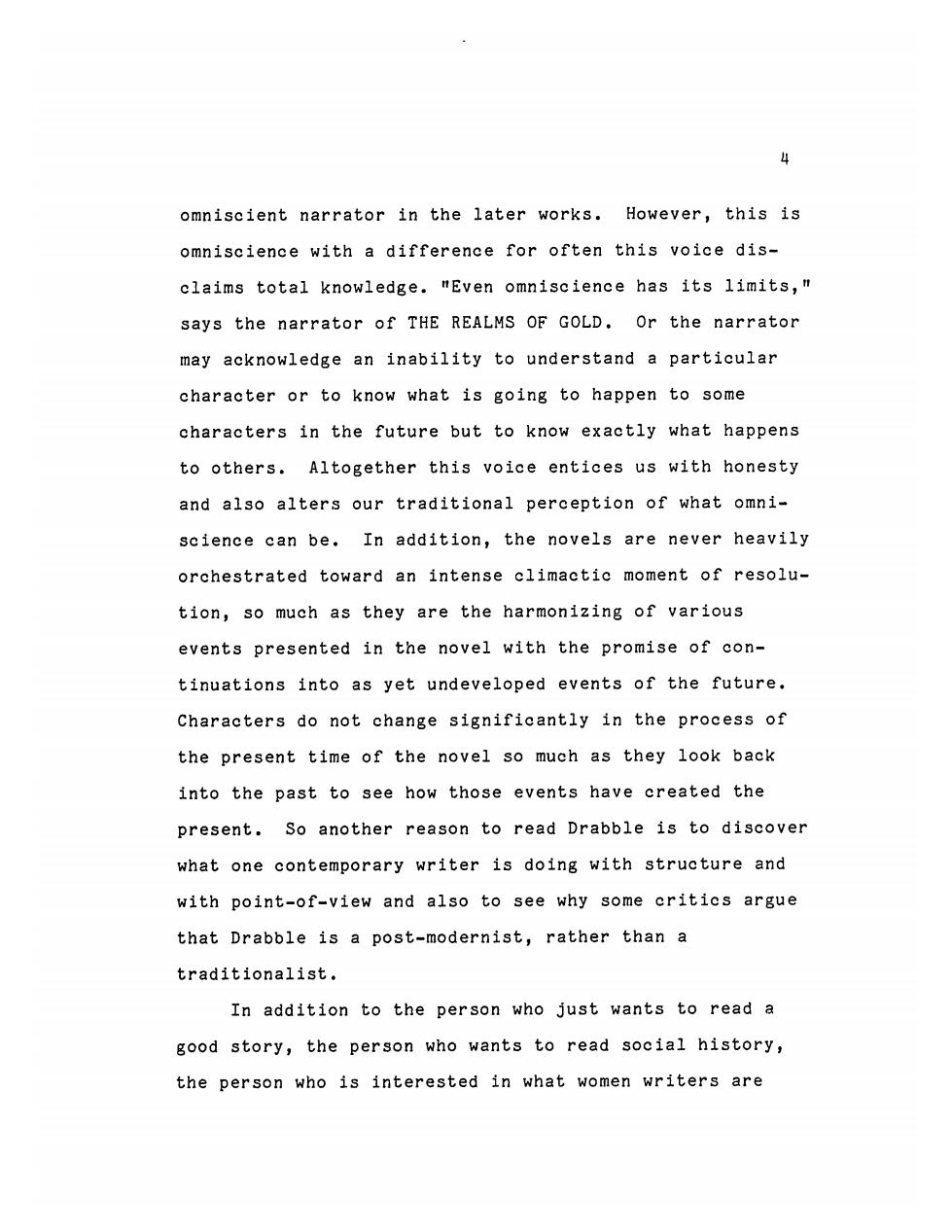
4 omniscient narrator in the later works.However,this is omniscience with a difference for often this voice dis- claims total knowledge."Even omniscience has its limits, says the narrator of THE REALMS OF GOLD.Or the narrator may acknowledge an inability to understand a particular character or to know what is going to happen to some characters in the future but to know exactly what happens to others.Altogether this voice entices us with honesty and also alters our traditional perception of what omni- science can be.In addition,the novels are never heavily orchestrated toward an intense climactic moment of resolu- tion,so much as they are the harmonizing of various events presented in the novel with the promise of con- tinuations into as yet undeveloped events of the future. Characters do not change significantly in the process of the present time of the novel so much as they look back into the past to see how those events have created the present.So another reason to read Drabble is to discover what one contemporary writer is doing with structure and with point-of-view and also to see why some critics argue that Drabble is a post-modernist,rather than a traditionalist. In addition to the person who just wants to read a good story,the person who wants to read social history, the person who is interested in what women writers are
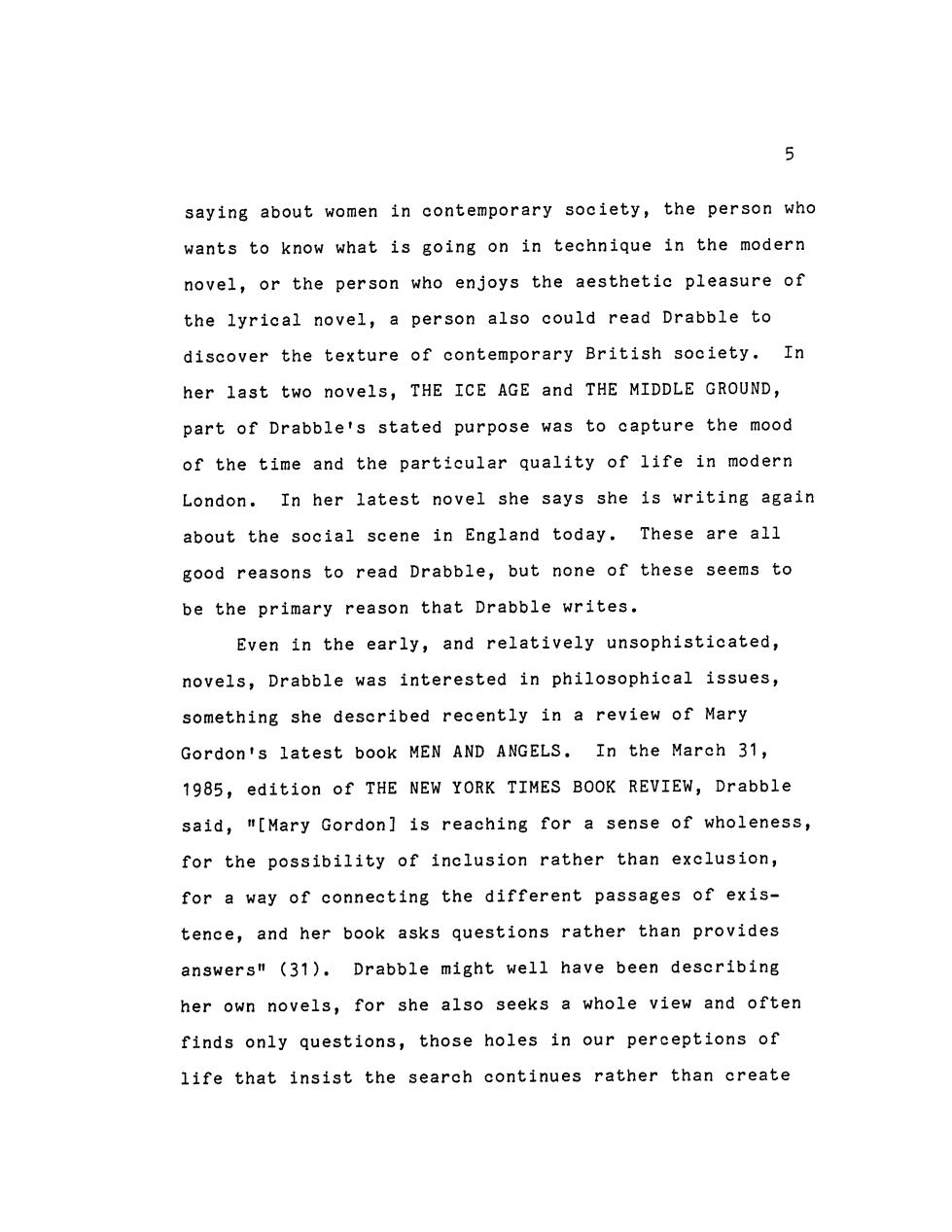
5 saying about women in contemporary society,the person who wants to know what is going on in technique in the modern novel,or the person who enjoys the aesthetic pleasure of the lyrical novel,a person also could read Drabble to discover the texture of contemporary British society.In her last two novels,THE ICE AGE and THE MIDDLE GROUND, part of Drabble's stated purpose was to capture the mood of the time and the particular quality of life in modern London.In her latest novel she says she is writing again about the social scene in England today.These are all good reasons to read Drabble,but none of these seems to be the primary reason that Drabble writes. Even in the early,and relatively unsophisticated, novels,Drabble was interested in philosophical issues, something she described recently in a review of Mary Gordon's latest book MEN AND ANGELS.In the March 31, 1985,edition of THE NEW YORK TIMES BOOK REVIEW,Drabble said,"[Mary Gordon]is reaching for a sense of wholeness, for the possibility of inclusion rather than exclusion, for a way of connecting the different passages of exis- tence,and her book asks questions rather than provides answers"(31).Drabble might well have been describing her own novels,for she also seeks a whole view and often finds only questions,those holes in our perceptions of life that insist the search continues rather than create